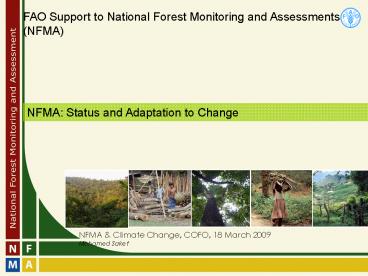NFMA - PowerPoint PPT Presentation
Title:
NFMA
Description:
NFMA – PowerPoint PPT presentation
Number of Views:42
Avg rating:3.0/5.0
Title: NFMA
1
FAO Support to National Forest Monitoring and
Assessments (NFMA)
NFMA Status and Adaptation to Change
NFMA Climate Change, COFO, 18 March
2009 Mohamed Saket
2
Inconvenient truth
- Fast facts
- NFI OR monitoring assessment processes
- How reliable what we know about extent of world
forest, change GHG emissions? - Countries have insufficient capacity to develop
and sustain forest monitoring and assessment
systems
3
As a result
- There is no information reliable, complete and in
the format which meets - National users needs for national policies
planning - Reporting to the international processes
- Weak readiness of countries for GHG reporting or
MARV under expected REDD mechanism
4
FAOs Response
- Strengthen FAOs activities
- Respond to countries requests and assist them in
building capacities in NFMA reporting - Develop cost effective, wide encompassing
integrated approach - Prioritise countries information needs for
policies, strategic planning from inter-sectoral
perspective, donor/investment planning
international reporting - Support implementation of international
agreements in methodologies, particularly
strengthening countries readiness for UNFCCC
GHG reporting
5
NFMA Process
Policy Reporting Needs D a t a c
o l l e c t i o n I n f
o r m a t i o n
NFI Systematic Field Sampling
National Policies Strategic Planning (poverty,
food security, livelihood, SFM, Climate Change,
etc) and International processes UNFCCC, CBD
etc.
Biophysical and Socio-economic properties of
forest and trees outside forest
Information
- Land use, land use change and forest (Area area
change) - Drivers of LU change
- Forest and tree attributes (volume, biomass,
carbon, biological diversity, health - Products services, use, users, management
- Maps (spatial distribution of resources
fragmentation, etc)
National Forest Monitoring Assessment
Mapping Remote sensing
Land use maps and area statistics (high precision
of rare events e.g. change monitoring)
Wall-to-wall or Sampling based
6
NFMA Way Forward and priorities
- Prepare FAO NFMA programme to be the reliable
tool land uses and forest covers (MARV) from
broad REDD perspective - Meeting changing policy exigencies new
international reporting requirements - Livelihood, peoples needs relation with natural
resources stronger emphasis on poverty food
security issues - Land use and forest cover changes (deforestation
forest degradation) their drivers
7
NFMA Way Forward and priorities
- NFMA approach will continue to improve through
expert consultations, partnerships feedback
from field projects - Methodological improvement
- Intensifying sampling when possible for improved
precision of rare events - Improving interview component socio-economic
data analysis - Reinforcing remote sensing land use maping
area change analysis - Expanding biophysical data to cover better carbon
pools in forest ecosystems - Improving data integration with models,
particularly for soil carbon estimates for GHG
reporting - Closer collaboration with research institutions
researchers - International regional expert networks for
awareness raising and coordinated work in
countries and across regions on NFMA - Cooperation/partnerships with initiatives/donors..
.. - Data-sharing dissemination
8
NFMA Experience on Costs
- Cost US 0.3 6 Millions, ( US 3,000/sample
unit Tract)
9
Estimates Sources Level of Precision
10
NFMAs Completed and in Progress
11
Pending Requests
12
Further information on NFMA
http//www.fao.org/forestry/site/nfma
13
- Thanks!































